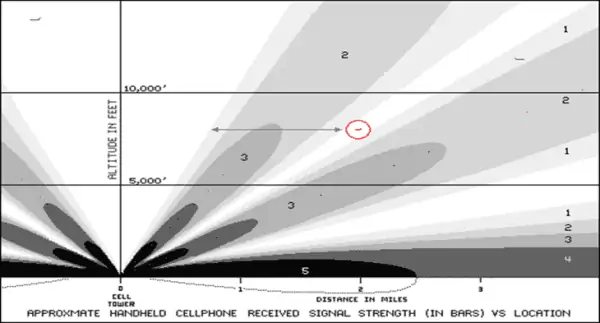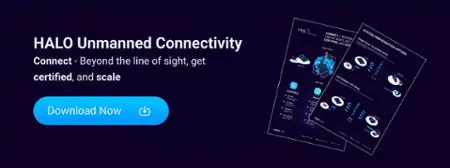In this article, Ben Gross from Elsight explains how the company’s Halo platform offers a solution for seamless drone connectivity with its ability to use up to four different cellular links from multiple network providers to monitor all available connections and switch to the best option should dropout occur.
One of the most crucial elements of successful drone operations is the provision of reliable communications and data link that provides continued connectivity as well as sufficient bandwidth to suit the mission’s particular requirements.
Up until now, the vast majority of commercial UAS (unmanned aerial systems) have used unlicensed RF (radio frequency) communications links. While this works just fine for many applications, it has several limitations.
RF datalinks require line of sight (LOS) between the ground control station and the drone. This means that for long-range BVLOS (beyond visual line of sight) applications to become a reality, a different technology is required that can push past this limitation. Another issue with unlicensed RF is that many portions of the spectrum are becoming overcrowded due to the increasing number of devices, and the capacity required to support mass drone adoption is unavailable.
SATCOM (satellite communications) is often used to solve these issues for larger UAV platforms, particularly military ones. However, SATCOM terminals are too bulky for many of the smaller drones commonly used for commercial tasks such as inspection and mapping. SATCOM services also typically require expensive data subscriptions that can eat into operating costs.
Cellular connectivity has the potential to bridge the gap. The modems required are small and lightweight, impacting minimally upon the SWaP (size, weight, and power) budget of the aircraft. Cellular-equipped drones can theoretically travel as far away from their control stations as required if they are in range of a cell tower serving their chosen network.
However, not everything is as easy as it seems. Several issues need to be investigated before cellular networks can be used to support drone operations on a large scale.
The RF environment experienced by aerial platforms
Cellular networks are largely optimized for users and devices at ground level. This means that the RF environment at the altitudes that drones typically fly at is very different.
On the ground, the line of sight between cell towers and cellular devices is often obstructed by objects and buildings. The elevation of a drone above these obstacles may thus result in it receiving greater signal strength from nearby towers. While this may be desirable if these towers are serving the drone’s cellular network, there will also be a direct line of sight to other non-relevant towers too. This can increase the level of interference and result in a low signal-to-interference-plus-noise ratio (SINR), which can affect the reception of vital messages such as handover commands.
The other major factor affecting the RF environment experienced by drones is the radiation pattern. Most cellular towers utilize directional antennas, which are designed to radiate as much power as possible in one particular direction. As most cellular devices are ground-based, this direction is likely to be downwards.
In addition to this main lobe, part of the radiation pattern for directional antennas is made up of side lobes. These are unavoidable lower-power emissions in directions that are usually not required for the main purpose of the antenna. Drones flying at particular altitudes may spend most of their mission time being served by these side lobe signals rather than the main lobe.
Connectivity challenges at altitude
Due to the nature of these side lobes, the pattern of cells that the drone may connect to is much more scattered than on the ground, where the most suitable cell is likely to simply be the one closest to the device. According to research performed by Ericsson, the pattern becomes particularly fragmented at altitudes of 300 meters and up.
What this means is that a flying drone connected to one particular cell via a side lobe may suddenly experience a massive drop in signal strength as it moves through the air, and this in turn may result in a dropped connection before handover to another cell can be completed.

Cell Tower Lobe Emissions. Note the position of the drone (red circle) between lobes (Source: Qualcomm)
Verizon is currently working in conjunction with the Federal Aviation Administration (FAA) to determine the limits and capabilities of its network in the United States to support UAS command and control. They are looking at what is known as CNPC (command and non-payload communications) – in other words, the transmission of data required to control the aircraft, and not considering the data transfer from cameras, sensors and other such equipment. It is possible that the bandwidth requirements for applications such as high-frame-rate 4K streaming video may require the enhanced capabilities of 5G rather than LTE.
Potential solutions for seamless drone connectivity
Several potential solutions could be employed to mitigate the effects of these different radiation patterns at altitude. Cellular networks may be able to employ additional features such as interference detection and enhanced handover management that are specific to the needs of UAS. Drone operators may also be able to make use of cellular mapping data that provides information on factors such as signal strength, channel capacity, and cell tower height, and plan operations accordingly.
The best way to boost your chances of maintaining rock-solid connectivity for your drone operations is to use a purpose-built solution that supports multiple network providers and uses automatic link monitoring to ensure constant connection.
Elsight’s Halo platform provides all this and more. Able to utilize up to four different cellular links from multiple network providers, it monitors all available connections and seamlessly switches to the best possible option should dropout occur.
Halo also uses AI-powered cellular bonding to aggregate the bandwidth of all usable connections into one robust and cybersecure link. The platform is 5G-ready and can be easily integrated into a variety of drone platforms, enabling you to be ready for next-generation use cases such as BVLOS.
To find out more about how Halo can provide the utmost in connection confidence for your LTE- and 5G-powered drones, get in touch.












